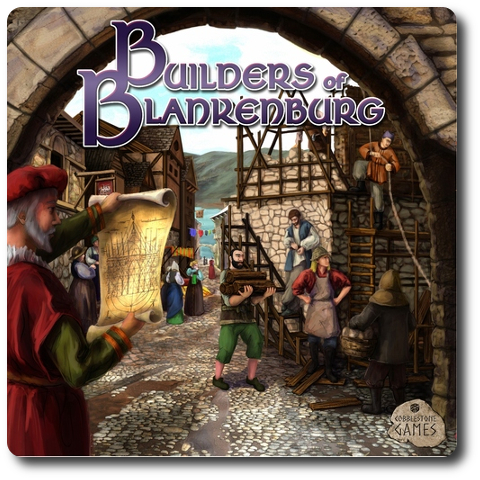
The Basics:
- For ages 8 and up (publisher suggests 14+)
- For 2 to 6 players
- Approximately 60 minutes to complete
Geek Skills:
- Counting & Math
- Logical & Critical Decision Making
- Reading
- Pattern/Color Matching
- Strategy & Tactics
- Risk vs. Reward
- Hand/Resource Management
- Bidding
Learning Curve:
- Child – Moderate
- Adult – Easy
Theme & Narrative:
- Build, destroy, and own the little town of Blankenburg
Endorsements:
- Gamer Geek approved!
- Parent Geek approved!
- Child Geek mixed!
Overview
To build something that lasts longer than our own life is a dream that many aspire to. Be it music, art, or a company. You are no different than the rest. You see the little town of Blankenburg as a means to an end. Here you will build and make a name for yourself that will last through the ages!
Builders of Blankenburg, designed by Peter Schultz and published by Cobblestone Games, is comprised of 1 double-sided game board, 10 Character cards, 21 Basic Plan cards, 10 Grand Plan cards, 17 Visitor cards, 25 Citizen cards, 15 Event cards, 25 Wood cubes, 25 Stone cubes, 15 Marble cubes, 15 Iron cubes, 15 Glass cubes, 1 Key to the Town (first player token), 10 Gold coins, 120 Silver coins, 84 Coat of Arms tokens (14 per player), 5 customized six-sided Resource dice, and 6 Player screens. The component quality is excellent. The game board is thick and durable and all the cards are as thick as your standard playing card. The tokens and cubes are made of thick cardboard or wood/plastic. The illustrations by Liz Stephanoff capture the different personalities in the game beautifully and help strengthen the game’s theme.
Property Speculation
To set up the game, first place the game board in the middle of the playing area. The game board is double-sided (more on that later). For now, use the side that has an illustrated town in the process of being built.
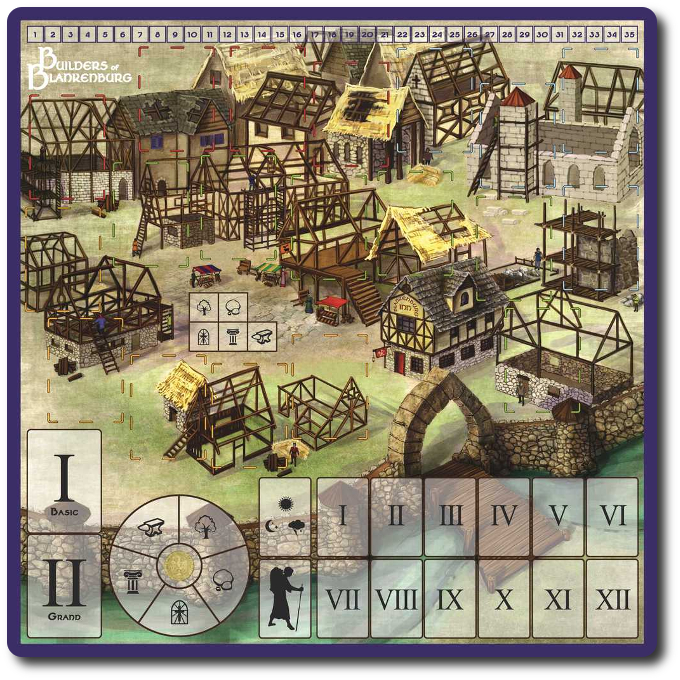
Second, give each player 1 Wood cube, 1 Stone cube, 12 Silver coins, 14 Coat of Arms tokens of their choice, and 1 Player screen. Players place 1 Coat of Arms token on the Prestige track found on the game board on the track’s lowest number position. Players should now place all their tokens, cubes, and coins behind their Player screen.
Third, find the 6 Basic Plan cards that have a star symbol and shuffle. Deal 1 to each player. These go in the player’s hand. Place the remaining Basic Plan on the game board. Shuffle the Grand Plan cards and place 1 face-up next to the Basic Plan card. Place the remaining Basic and Grand Plan cards in their own draw decks and face-down next to the game board.
Fourth, shuffle the Character cards and deal 1 to each player. This is the player’s character for the duration of the game. Any Character cards not dealt are returned to the game box. The Character card is placed in front of the player and any adjustments are made to their current wealth and prestige. Note that many of our players wanted to keep their Character hidden after players knew who they where playing as, which provided an additional level of complexity.
Fifth, find the Citizen cards with the star icon, shuffle and deal 1 per player in the game to the game board, face-up, on the Roman numeral track (referred to as the “Citizen track”) on the game board. Shuffle the remaining Citizen cards in with the rest and place face-down next to the game board.
Sixth, shuffle the Visitor deck and the Event deck separately and place face-down next to the Citizen deck.
Seventh, place the cubes and coins into organized piles off to one side of the game board. These are the resource pools. Place a number of each resources equal to 1 fewer than the number of players on the Marketplace area found on the game board.
That’s it for game set up. Determine who will go first and give them the Key to the Town.
The Pros and Cons of Medieval Property Management
Builders of Blankenburg is played in rounds and turns with no set number of rounds per game. All players participate in a game turn and in turn order sequence starting with the player who has the Key to the Town. A game turn is summarized here.
Phase 1: Bidding
The player who has the Key to the Town selects any combination of resources from the pools to be bid on, but the total number must be 1 less than the number of players. The selected resources are placed on the Marketplace bidding wheel location on the game board. A number of Resource dice are rolled equal to the number of players. The resulting resources are then added to the Marketplace bidding wheel, as well. Since Stone and Wood resources are considered common, 2 resource cubes of that type are added for every 1 rolled.
Each player now secretly determines how many coins they want to spend to acquire the resources. The player who spends the most will be able to pick first, followed by the second player who spent the most and so on. Once each player has decided, all players reveal their bids at the same time. The highest bidder takes the resources (max 3) of one type (plus 1 Gold coin if available), followed by the second highest, and so on. Bidding is optional and in case there is a tie, the player closest to the Key to the Town wins. Players bidding zero do not get to collect resources, but are given 3 Silver coins. Any resources not claimed remain on the bidding wheel.
Phase 2: Building
Starting with the Key to the Town player, each player has an opportunity to build 1 Plan from their hand or use a Communal Plan (those face-up on the game bard). Before building, the player should take note of a few specifics.
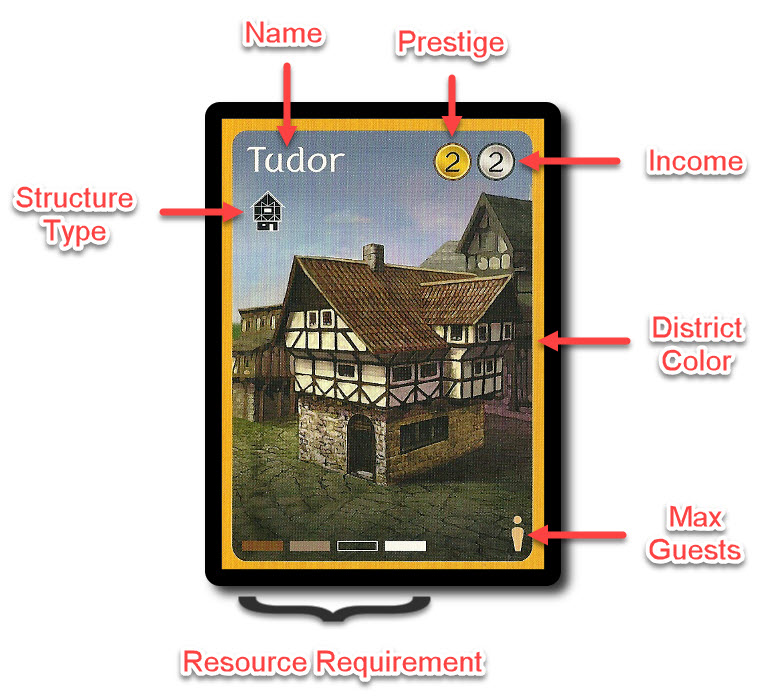
- Name and Structure Type: These identify the name of the building and what type it is. They symbol for the Structure Type is used to quickly identify what buildings are available to guests.
- Prestige and Income: The prestige value will award player points that are necessary to win the game, while the income shows how much Silver the player will earn per guest that stays in their building.
- District Color: There are 4 different districts and each is identified by color (civic is red, commercial is green, religious is blue, and residential is yellow). There are only so many places to build in the town and even fewer places to build per district.
- Max Guests: This shows the total number of guests that can stay in the player’s building. The bigger the number, the more income to be earned.
- Resource Requirement: This shows the type and number of resources needed to build and place the card.
If the player has the right number and type of resources (or 1 Gold coin for every missing resource), and there is an open space in the matching district, the player can pay the resource cost and place the Plan card. When they do, they also place a Coat of Arms on the card, indicating that is belongs to them. The player then advances their Coat of Arms token on the Prestige track.
Due to limited space in the districts, the player can optionally demolish a building they own if they want to make room for another building. Demolishing a building might also be a good idea if it was damaged due to an event in the game. For example, an Inn suffering a fire cannot hold as many guests, becoming less profitable. Demolishing it and building an even LARGER Inn would be a smart move. Or, if the player likes, they can spend resources to repair damaged property.
Phase 3: Income
This phase requires several steps.
Step 1: Reveal Event Card
The top-most Event card is drawn and revealed. It’s immediately read out loud and resolved. Events effect all players.
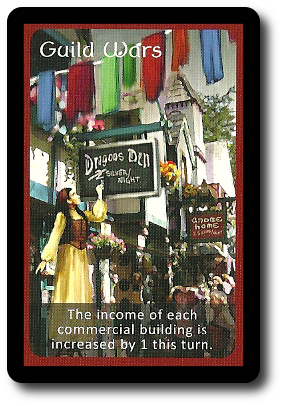
Step 2: Reveal Visitor Card
The top-most Visitor card is drawn and revealed. It’s immediately read out loud and resolved. Events may impact how the Visitor acts during the round.
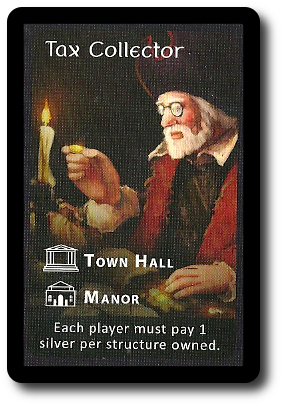
Step 3: Check Lodging
Starting with the Visitor card and the current Citizen cards, each is checked to determine where they will stay. The cards will have a preference and will stay at certain locations if they are visible. If not, they will stay at the Inn by default. This is where players make their income.
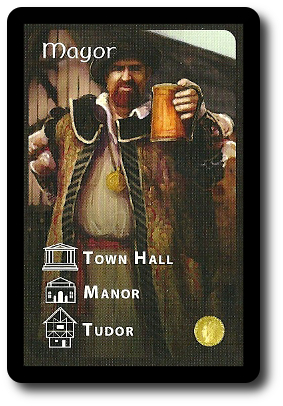
Phase 4: Marketplace
This phase allows the players to spend their hard-earned Silver to purchase additional plans and more resources. Unwanted plans in the player’s hand can be sold/discarded for new plans.
After all the players have finished purchasing plans, everyone can purchase resources. Resources can also be sold.
Phase 5: End of Turn
This phase resets the resources for the next round and the plans. If players have more resources than they can currently hold, they must discard down until they have hit their maximum. A new Citizen card is also drawn and placed to the game board, representing the town’s growth and overall prosperity thanks to the players.
Finally, the Key to the Town is passed to the next player in turn order sequence.
Thus ends a single game turn. A new game turn now begins starting with phase 1 noted above.
Boarding Up the Properties
The game ends if there are no available spots to build, in which case the town is considered “built”, or if there are no more spaces available to place a Citizen card. Whichever comes first.
Final scoring is determined by counting Prestige, resources, and building types. The player with the most points wins the game.
Game Variants
A few game variants are available. They are summarized here.
A Town for Two
The game is played very much the same as the other games, but allows players a great deal more time and focus to build their strategy.
Master Builder
The Master Builder game variant is used when playing with 2 players and introduces a 3rd non-player to the game. This changes the game play a great deal and puts it more in line with a 3-player game.
Alternate Game Board
The other side of the game board depicts an illustration of a city layout. Additional building spaces are provided. This side of the game board is recommended for games containing 5 to 6 players.
Six Players is a Party
The most cutthroat version of the game, challenging players to be as strategic as possible. Resources are limited, and if the player doesn’t think things through, they could be left bankrupt.
To learn more about Builders of Blankenburg, visit the game’s web page.
Final Word
The majority of Child Geeks quickly understood how the game was played and got to it. The phases in the rounds are easy to follow and each round is focused on only 1 or 2 tasks. But there were two issues that kept coming up that caused some of our Child Geeks to grow disinterested. First, the games tended to last longer than they wanted them to. A game could last up to 90 minutes, meaning a lot of the Child Geeks were becoming disinterested. Second, and directly related to the first, this is a game where the players must keep themselves engaged if they are to do well. Things move quickly and if players aren’t watching the game board, managing their resources, and thinking ahead, they will be left in the dust. Not left forever, but it can be very difficult to catch up once you fall behind. According to one Child Geek, “I like the game OK, but I just don’t like how long it takes.” Another Child Geek said, “I think it’s a great game, but you have to want to play it. This is not a game you can half pay attention to.” When the votes were in, the Child Geeks gave Builders of Blankenburg a mixed endorsement.
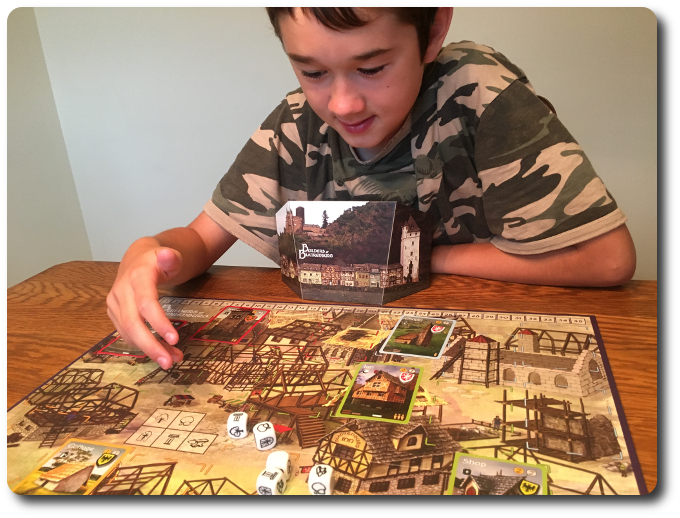
My son explains to me why I lost the game while I put it away – a mixed parenting moment
The Parent Geeks really enjoyed themselves, finding the game to be a solid example of a Euro-style game, but without the heavy feeling that some Euro games tend to exude. According to one Parent Geek, “Easy to follow phases and visually interesting game play make this a real winner.” Another Parent Geek said, “I like the game a lot. It has just the right level of challenging game play and light decision making. I’m surprised I haven’t heard of this game.” Builders of Blankenburg also turned out to be an excellent family game, playing very well with different skill and age levels, although it was always obvious that the more skilled players were dominating. When everything was built, the Parent Geeks approved the game.
The Gamer Geeks found Builders of Blankenburg to be well designed, good depth of play, with an interesting mix of decision making. They thought the game play got a little stale at times, what with the never-changing decision making, but they accepted that fairly quickly. According to one Gamer Geek, “I think this is a great example of a game designer who designed a Euro-style game by taking all the elements they liked best. I think they did a great job.” Another Gamer Geek said, “There are a few areas in the game that I think could be tightened, but I gotta say, this game is pretty entertaining.” When the votes were in, the Gamer Geeks voted to approve Builders of Blankenburg.
This is a good game. It has well-defined actions, limits, little luck, and a lot of information. The player is greatly empowered, but is not powerful. The player must work to get an advantage, and once they have it, they can lose it if they don’t pay attention. The game keeps you engaged, manages to challenge you without aggravating, and handles randomness and change in a way that is nondestructive. That’s no small feat.
The game’s rule book is hurting. I pride myself in reading lots of game material and being able to quickly understand what the designer intended. Not the case with Builders of Blankenburg. The rules of the game are explained and in-depth, but the rule book is not organized in such a way that allows the reader to easily learn them. Content is divided into large chunks of text, making it difficult to pull out the most important aspects of the rules and game play. It’s difficult to scan the rules to find specific information. This will lead to confusion and frustration, but take heart. Everything that a player needs to know is documented in the rule book. It’s complete, as far as rule books go. It’s just not an easy one to navigate.
I am very pleased with the game. Builders of Blankenburg is a game I would put in front of new and skilled players alike. Other than the rule book that takes more time than necessary to read and understand, the game is very much in sync with itself and its players. Do try this hidden gem of a game and see if it builds its own reputation with your playing group.
This game was given to Father Geek as a review copy. Father Geek was not paid, bribed, wined, dined, or threatened in vain hopes of influencing this review. Such is the statuesque and legendary integrity of Father Geek.



